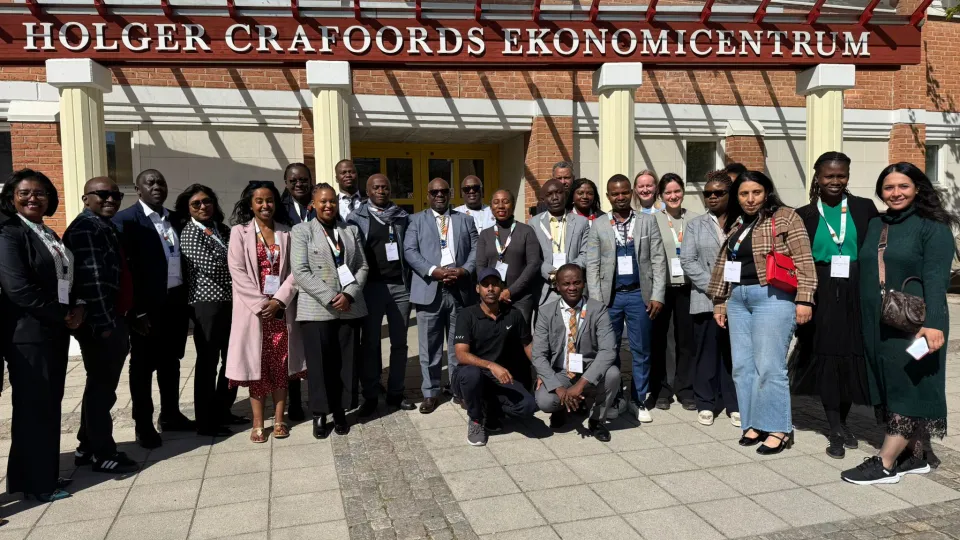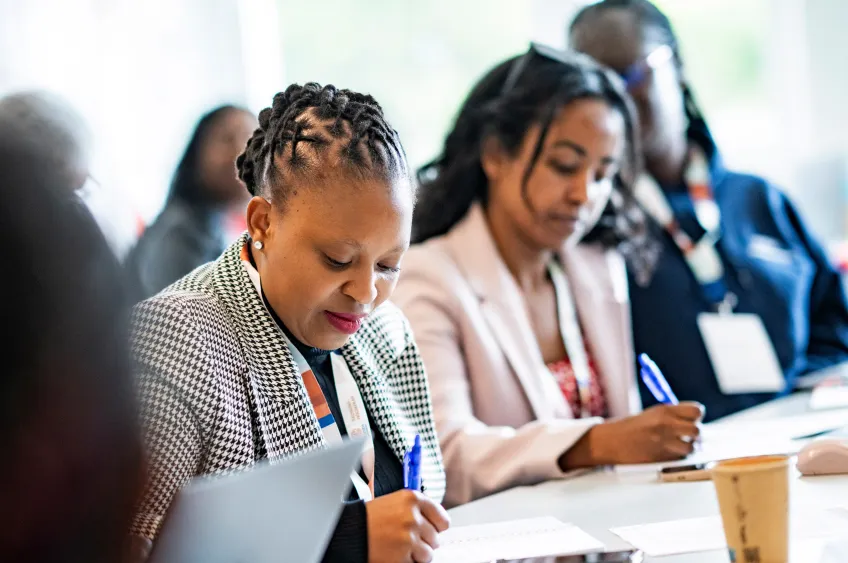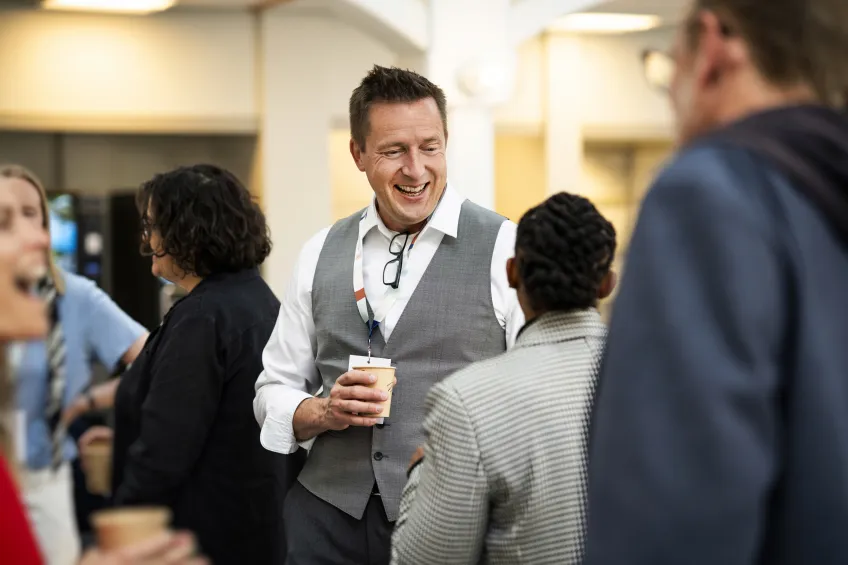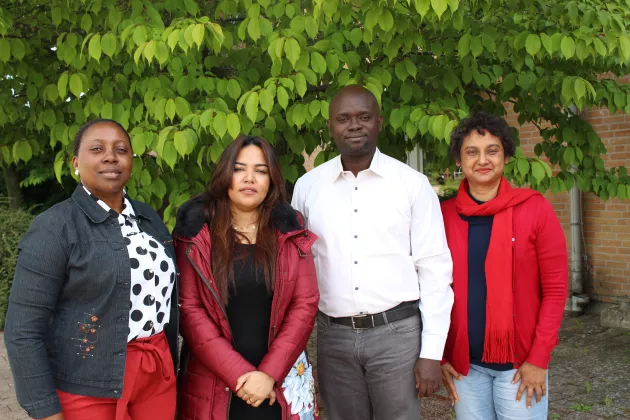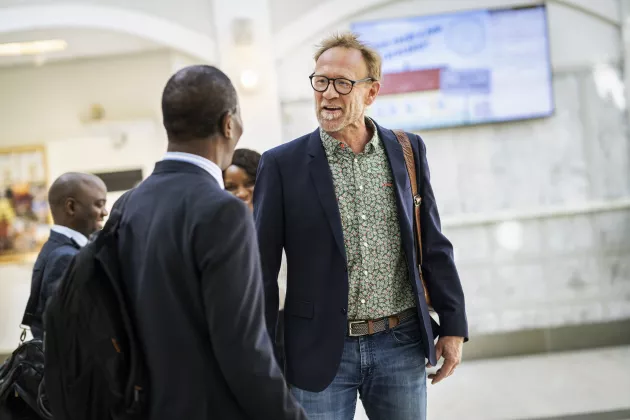From 2022–2025, Lund University had delivered four iterations of a capacity development course Innovation, Transformation and Resilience for Sustainable Development. This is a part of a larger project to strengthen the development and use of science, technology, and innovation (STI) indicators in Africa. The course ultimately aims to contribute to the continental vision known as Agenda 2063, ‘The Africa We Want’. The fourth round of the course was as usually located and given at LUSEM where about 15 – 20 researchers, from LUSEM and other faculties and universities, gave lectures during the course. As always, we took the opportunity to speak with a few course participants to hear their thoughts on the course and their impressions of Lund, and to get some updates from the project manager and course leader.
Unexpected lessons learned
Tinyiko Ntshongwana comes from South Africa and is the Deputy Director of Africa Multilateral Cooperation at the Department of Science, Technology and Innovation. Speaking about surprises in a Swedish context she says that it surprised her learning that uptil about 150 years ago Sweden was one of the most poorest countries in Europe, barely industrialised and with a largely agrarian way of life.
“It was also interesting to note from one of the seminar’s which gave us a glimpse into Sweden’s economic history, that the church through its provision of education and the industrial revolution, ushered in a turning point in Sweden’s economy which embraced the emergence of mechanisation to industrialise and open up its economy to international trade,” says Tinyiko.
She describes other unexpected lessons learned during the course, such as that innovation has often emerged in countries during critical points of crises with socio-economic and political turmoil.
“This was the case in point during World-War II for some countries in Europe and post World War II for the East Asian countries such as Japan, China and Korea. During the course I learned that the latter, in the Post World War II period were poorer than most African countries. Today however Japan, China and South Korea are amongst the top performing economies globally. These examples offered a diversity of views of how African countries, including South Africa where I am from, can pivot in addressing poverty, inequality and unemployment and more importantly in using innovation to achieve economic resilience,” Tinyiko explains.
Fortunate Muyambi also participated in the course. He is from Rwanda and work as Deputy Executive Secretary (Head of Programs and Projects) at East African Science & Technology Commission (EASTECO). What does he think has been most surprising?
“What surprised me most during the programme in Lund was the deeply institutionalized culture of sustainability and innovation that permeates Swedish society. It was eye-opening to see how innovation policy in Sweden is not just a set of aspirational documents but an operational reality embedded across government, academia, and industry. This stands in stark contrast to the fragmented and often siloed approaches to Science, Technology, and Innovation (STI) that I have observed in many East African systems. Particularly striking was Sweden’s emphasis on resilience through data-driven, cross-sector collaboration — a model that aligns closely with our regional ambitions under the African Science, Technology and Innovation Indicators (ASTII) Phase IV initiative,” Fortunate says.
He also says that several components of the programme made a strong impression on him. For example he found the session with VINNOVA, Sweden’s innovation agency, especially insightful since it demonstrated how effective institutional coordination, powered by real-time data, can guide inclusive and adaptive innovation strategies. Site visits to for example Ideon Science Park further brought these ideas to life, illustrating how academia and industry can be effectively linked to drive innovation ecosystems. These experiences gave Fortunate concrete ideas for how East African countries might build robust STI data systems that are inclusive, policy-relevant, and grounded in local realities.
‘Light-bulb’ moments
Both Tinyiko and Fortunate highlight the value of learning in a diverse and engaged group of peers from across the African continent. The mix of experiences, challenges, and ideas sparked new perspectives — and laid the foundation for future collaborations.
“Learning alongside peers from across Africa was both intellectually stimulating and deeply collaborative,” says Fortunate. “We tackled common STI challenges and shared local solutions, which broadened my perspective and inspired future initiatives.”
“The course brought together dynamic individuals from different sectors who challenged my thinking,” Tinyiko says. “Many discussions gave me ‘light-bulb’ moments — insights I’m eager to apply at home. I know that I am connected to a network of experts who will be crucial as I go back to my organisation, to implement the learnings from the course.”
“The knowledge I’ve gained here is already shaping my professional outlook“
The programme has offered new perspectives that Fortunate now aims to apply in his work to strengthen innovation and policy in East Africa. He sees clear opportunities to enhance the STI indicators database in East Africa by using digital tools for real-time data and improved coordination across the region. The programme’s focus on systemic innovation has also shifted his view of policy — from a static tool to a dynamic and inclusive process. More broadly, his understanding of innovation and development has evolved toward a more systemic and adaptive approach, grounded in institutional resilience and community engagement.
“The knowledge I’ve gained here is already shaping my professional outlook,” he summarises it .
The course offered several new perspectives on innovation and policy, which Tinyiko believes could be valuable in her work. She believes the course has provided greater clarity on key aspects of policy implementation, helping to address institutional gaps and identify new ways to accelerate innovation. One important insight was the need to move beyond traditional innovation indicators such as R&D and patents, and instead consider measures that capture broader industrial activity. The Swedish approach, where government and municipalities play an active role in the innovation ecosystem, also offered valuable perspectives that could inform future efforts in South Africa.
Success and continued relevance
Martin Andersson, Senior lecturer in Economic history at LUSEM and leading the course says that this fourth round was in fact the final year of the current four-year project cycle, which has been funded in phases by Sida since 2007. It marks the fourth phase of the ASTII project (African Science, Technology and Innovation Indicators Initiative). However, given the success of the course held in Lund and its continued relevance, Martin has received confirmation of funding for a one-year extension. This means that the course is also planned for 2026, which he is very pleased about.
“The extension gives us time to apply for funding from Sida — and other potential funders — for a fifth phase of the project starting in 2027 and beyond. A Memorandum of Understanding has just been signed by the Vice-Chancellor of Lund University and the Director-General of AUDA, the African Union Development Agency, further emphasising the strong partnership we have built and supporting continued collaboration,“ Martin explains.
And what are his thoughts on the future?
“I remain hopeful that the project — including this capacity-building course hosted by the Department of Economic History — can continue to receive support, despite the current reductions in development aid budgets and shifts in development policy. The project plays an important role in strengthening African countries’ ability to generate measurable indicators on their own national strengths and weaknesses in relation to the drivers of economic development. This, in turn, enables more effective development policies — which ultimately benefit everyone, including us in the global North.“
According to Martin, the growing demand speaks to the course’s relevance and impact since the interest in the course itself continues to grow among public officials across the continent.
“This year, we received over 700 applications for just 24 places, making the programme highly competitive and ensuring that participants are both motivated and well qualified.“
Deepening collaboration
Ida Burguete Holmgren, Project Leader of this commissioned training tells that as a testament to the shared commitment to deepening collaboration, Lund University and AUDA-NEPAD are set to sign a Memorandum of Understanding (MoU) before the summer. This formal agreement underscores both parties’ dedication to exploring further opportunities for joint initiatives.
“This year, we also had the privilege of welcoming Vincenzo Lorusso, Policy Officer at the European Commission’s Directorate-General for Research and Innovation, and co-chair of the AU-EU Innovation Agenda Working Group, together with Lukovi Seke from AUDA-NEPAD. Mr. Lorusso plays a central role in advancing scientific cooperation between the EU and Africa and shared valuable insights from the AU-EU Innovation Agenda during his visit,“ Ida explains.
In addition, the programme was also pleased to host representatives from AUDA-NEPAD: Professor Brando Okolo, Head of the Office of Science, Technology and Innovation, and Mr. Lukovi Seke, Principal Programme Officer for African STI Indicators.
Workshop and alumni gathering in South Africa
Last but not least, Ida gives us interesting, positive information about what's coming up next:
“As part of our continued engagement, we are also preparing a new joint proposal to Sida in collaboration with AUDA-NEPAD. In June, we will hold our first official workshop in South Africa, bringing together representatives from AU member states and alumni from previous programmes—an exciting step forward in strengthening partnerships and impact.“
